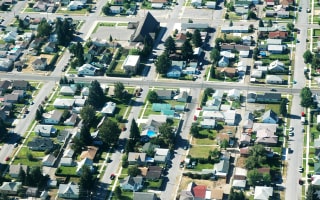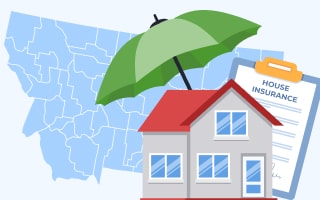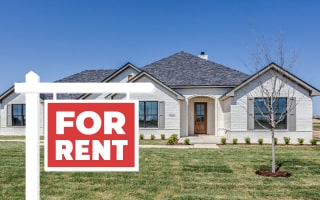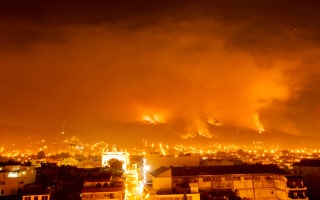Homeowners Insurance in Montana

Called "Big Sky Country", Montana is home to the Rocky Mountains and Great Plains and sits squarely in the western part of the country. It also borders Canada. Some common weather events that occur regularly in Montana are earthquakes, wildfires, and heavy snowstorms, all of which can cause severe property damage. Although generally safe from hurricanes and tornadoes, the state does see some flooding. Since 1953, Montana has had 68 federally declared disasters, and the rate of disasters per 1 million people is 59.51.
Along with some weather-related disasters, Montana residents also file insurance claims for lightning, fire, hail damage, ice and snow damage, theft, liability, vandalism, and burst pipes, resulting in water damage.
Just because states don't require any homeowners insurance doesn't mean you don't need it. Experts recommend that anyone owning property have at least some coverage. If you need a mortgage to buy the property in Montana, your lender will require you to purchase home insurance with specific limits and keep it active until you pay off the loan.
As of September 2024, the average rate for homeowners insurance nationwide is $2,728 per year. Montana residents pay an average of $3,800 yearly for homeowners insurance, much more than the average, despite fewer disasters than other states.
Types of Homeowner Insurance Coverage Available in Montana
Every state has different insurance providers who offer specific types of home insurance coverage for the area and potential dangers. Montana is considered a relatively safe state, so residents have plenty of providers to choose from and reasonably affordable rates. The available coverages in Montana include:
-
Dwelling Coverage: Dwelling coverage protects the structure of your home (roof, walls, electrical, plumbing, etc.) and pays to replace or repair your house after a qualifying event.
-
Personal Property Coverage: Personal property insurance pays to replace your personal belongings if they are stolen or destroyed in a covered peril.
-
Other Structures Coverage: Other structures coverage pays to replace detached things like garages, sheds, pools, and fences.
-
Liability Coverage: Liability insurance pays your legal bills if someone gets hurt on your property and then sues you.
-
Medical Payments Coverage: If anyone is injured on your property in Montana, medical payments coverage will pay their medical bills.
-
Additional Living Expenses (ALE) Coverage: When your home is destroyed, and you must move out while it is being repaired or rebuilt, ALE coverage pays for your expenses (food, lodging, laundry, pet services, etc.).
Since Montana also experiences frequent flooding, homeowners should consider implementing a flood policy. Umbrella policies are also suitable for filling in where another policy leaves you vulnerable.
FEMA (Federal Emergency Management Agency) manages the National Flood Insurance Program (NFIP) through a network of 50 providers across the U.S.
Since most homeowners insurance does not cover floods, this supplemental coverage can repair damage and replace items after a flood. Depending on the options you choose, it can cover the building and/or your personal belongings. This program is available to homeowners, renters, and businesses. Learn more about the program on FEMA's website.
Home Insurance and Natural Disasters
Climate change due to global warming is inexorably linked to homeowners insurance and climbing rates. The U.S. is experiencing more disasters than ever before, even in parts of the country that were historically considered calm. Severe weather is the number one reason for rate increases across the country. Over the past five years, rates have increased by 34% and even as high as 60% in some places. In Montana, rates have increased by 34.1%.
Montana has some earthquakes, wildfires, flooding, and severe winter storms with heavy snow. All of these can tragically damage a house or other structures.
Luckily, in 2023, Montana only had four tornadoes. But in 2022, the state experienced 2,087 wildfires, destroying 137,509 acres and much property. That number of wildfires ranked Montana in the #9 slot for most in a year and most acres damaged. The number of properties at risk of wildfire in Montana is 137,800. Fire and lighting claims average $77,340 for just one. Wind and hail claims average $11,695, and water, snow, or ice damage average $11,650 per indent. From 2015 to 2019, insurance providers in Montana lost $192,382,800. From 1980 to 2024, Montana had 35 billion-dollar disasters.
How Can I Save on Homeowner Insurance Premiums in Montana?
Property owners must find creative ways to save with homeowners insurance premiums rising. Before saving money on your rates, you must fully understand what factors impact home insurance costs. In Montana, those factors are:
-
Location: The most critical factor is where you live. If you live in an area prone to disasters or crime, you will pay a lot more than if you live in a safe, quiet location.
-
Size and Condition: The size and condition also matter. The larger the house, the more it will cost to rebuild. Homes in good condition cost less to insure than those falling apart.
-
Age of the Home: Newer homes cost much less to insure, and older homes cost more.
-
Construction Materials: How you build your house matters as materials and labor costs rise. If you build it with expensive materials, your insurance will be higher.
-
Your Credit Score: People with good credit pay less for homeowners insurance than those with bad credit.
-
Claims History: If you have a long history of claims (even with a different provider), you will pay more than if you have a clean claims history.
-
Coverage Amount: The more coverage you need, the higher your premiums will be.
-
Pets: Some dangerous pets make your home riskier, and you will pay more for your insurance.
-
Attractive Nuisances: Although fun, attractive nuisances like pools, hot tubs, tree houses, and trampolines cost more to insure because they add risk.
-
Finance or Own: If you own your house, you can decide how much coverage to buy and set limits. If you finance your home, your lender will choose your limits, and you must keep it covered for the duration of the loan.
Some ways to save on your homeowners insurance are:
- Avoid High-Risks: Avoid adding anything to your home that adds risk, and eliminate those you can to save money.
- Bundle Your Policies: Bundle your home and auto insurance together with the same provider, and they will give you a discount.
- Make Your House Stronger: Reinforce your roof, windows, and siding to make your house more weather-resistant, and you could save on your premiums.
- Improve Your Credit: Improve your credit score and ask your agent to re-evaluate your rates based on the new higher score.
- Add Home Security: Install a home security system to make your house safer and reduce rates.
- Increase Your Deductible: The more you increase your deductible, the lower your premiums.
- Ask for Discounts: Ask your agent for any discounts that might apply to you.
- Don't File Small Claims: Don't file any small claims; wait for bigger things.
- Compare Quotes: Compare quotes before deciding who to sign up with.
Home Insurance Discounts in Montana
Property owners purchase home insurance to protect their homes in the event of a disaster like fire, hurricane, or tornado. After a qualifying event, the insurance company will pay to repair or rebuild the home back to its current condition. Most policies include personal property protection, liability and medical payments insurance, and loss of use (ALE) coverage.
You can purchase home insurance by choosing a firm, applying online through their website, or calling them by phone. You can also work with a local agent who is familiar with your market and can help you determine the best policy, coverage, and rates for your situation.
Some common discounts offered by most insurance providers include:
- Senior Citizen Discount: Many firms give seniors or retirees a special discount when they reach a certain age.
- Loyalty Discount: If you stay with the same company year after year, they may offer you a discount as time passes.
- Bundle Discount: Bundle multiple policies and earn a discount on your rates.
- Military Discount: Most firms offer discounts on home insurance to members of the military or veterans.
- Occupational Discount: Some professions, like firefighters and teachers, earn discounts.
- Non-smokers Discount: Non-smokers offer less fire risk, and insurers discount them.
- Autopay Discount: Your carrier should offer discounts if you sign up for auto payments.
- Paperless Discount: Going paperless is good for the environment and your rates.
- Quote In Advance Discount: Get a quote well before you need it, and you might get a discount.
- Security Discount: Install a security system to avoid theft and vandalism, and your insurance provider will give you a discount.
- Fire-Safety Discount: For a discount, install fire safety equipment like sprinklers, smoke alarms, and fire extinguishers.
- New Home Discount: New homes cost less and sometimes get a big discount.
- Green Discount: Install eco-friendly materials in your home for a discount.
Common Rates Offer by Homeowners Insurance Firms
New homes cost roughly 40% less to insure than older homes. Even homes as young as five years old earn a discount of up to 26% off home insurance. The average cost of home insurance on a new home in Montana is $1,700 a month, which is considerably less than the national average. However, your actual rate will depend on many factors, like your location, the size of your home, deductible, coverages, your credit score, etc.
Top 10 Home Insurance Firms in Montana and Average New Home Savings
| Company | % savings |
|---|---|
| Nationwide | 76% |
| Amica | N/A |
| State Farm | 51% |
| Travelers | 63% |
| Allstate | 47% |
| USAA | 54% |
| Chubb | N/A |
| Liberty Mutual | N/A |
| Cincinnati Insurance | 52% |
| American Modern | N/A |
Home Insurance and Renovations in Montana

Home renovations liven up your space and invigorate your life, but they can also dramatically impact your home insurance rates. Some upgrades help fortify your residence, making it safer and less costly to insure. Others, however, can increase the value, size, or risk, and your rates will go up as a result. Still, other updates may increase and decrease your rates, canceling each other out.
![]() Home Renovations that Increase Rates
Home Renovations that Increase Rates
Some home renovations that increase your rates include:
- Building an Addition: You add space and value when you build an addition for whatever reason. More space and value mean higher premiums on your home insurance.
- Luxury Upgrades: Adding granite countertops, high-end appliances, and expensive lights and faucets can do wonders for your kitchen, but it also makes the home more expensive to rebuild, and therefore, your rates will go up.
- Getting a Trampoline: Trampolines are considered attractive nuisances that add a lot of risk, and insurers charge more when these are on-site.
![]() Home Renovations that Decrease Rates
Home Renovations that Decrease Rates
Some home renovations that decrease your rates include:
- Update the Infrastructure: Updating your home's infrastructure (foundation, roof, wiring, plumbing, and HVAC systems) can strengthen your home and make it safer and more valuable. Being proactive will also lower your rates.
- Earthquake Resistance Retrofits: Anyone who lives in an earthquake-prone area should reinforce their home with straps, ties, and shatterproof windows. Insurers also reward you with money off your premiums.
- Water Alarms and Auto Shut-Off Devices: Water damage is expensive. You can avoid this costly peril by installing automatic water shut-off devices and alarms and lowering your home insurance rates.
Generally, replacing your roof is a good idea. It will help make your home more weather-resistant and should lower your home insurance rates. However, using costly materials when replacing the roof could also increase its value and your rates.
You must pay for renovations yourself whenever you decide to update your home for personal reasons or regular maintenance. Home renovations are not covered under your home insurance policy. Your homeowners insurance only pays to repair or replace the home after a qualifying event. Home insurance does not cover pests, animal damage, and rodents.
Before beginning any renovation, always speak to your insurance agent first. They can help you determine the work's effect on your rates and coverage. You may need to adjust things after the project is complete.
Montana Renters' Insurance

Montana residents who rent homes (condos, houses, and apartments) also need homeowners insurance. Renters insurance is a special kind of homeowners insurance that protects and replaces your personal belongings after they are stolen or after a covered peril like fire, smoke, hail, frozen pipes bursting, lightning, vandalism, or windstorm. The thing about renters insurance is that it has no dwelling coverage; that must come from the owner's policy. Most renters insurance also includes liability, medical payments, and loss of use.
Some of the things that renters insurance covers are:
-
Furniture
-
Clothing
-
Electronics
-
Small Appliances
-
Bedding
-
Bath Items
-
Sports Equipment
Every policy has limits, and expensive jewelry, motorized vehicles, and home office equipment may not be covered.
Renters insurance is priced based on three main factors:
-
Location: As with other types of insurance, location matters. If you live in a city with higher crime or frequent windstorms, you will pay more than in a safe, quiet area.
-
Coverage: The more coverage you buy, the higher your rates will be.
-
Number of Units: The more units in your building, the lower your rates will be.
The average rate for renters insurance in Montana is $168 per year. If you live in the city, you will pay higher rates than if you live in the suburbs or rural areas where crime is lower.
Condo Insurance in Montana

Condo insurance is homeowners insurance for condo owners, but it works differently. Condo associations have master policies that protect each building in the development. After a qualifying event, that master policy will pay to repair or replace the condo back to its original condition (when it was first built). The problem is that most condo owners have significantly updated flooring, kitchens, cabinets, countertops, baths, lighting fixtures, and appliances. Their condo insurance restores those items and everything else from the "walls in" back to its most current condition. Condo insurance also includes personal property protection, liability and medical payments insurance, loss assessment, and loss of use (ALE).
Unlike renters insurance, which has no dwelling coverage, condo insurance has limited dwelling coverage (walls-in only). The liability portion only applies if the person gets hurt inside the condo. Condo insurance will replace:
- Interior Walls
- Flooring
- Wiring
- Plumbing
- Furniture
- Appliances
- Countertops
- Cabinets
- Personal Possessions
The average cost of condo insurance in Montana is $486/year or $40/month for $60,000 of personal property coverage and $300,000 of liability protection with a $1,000 deductible.
You can save on condo insurance by following these tips:
- Raise Your Deductible
- Improve Your Credit
- Stay Claims Free
- Shop Around for the Best Rates
- Bundle Policies
- Improve Home Security
- Install Fire Safety Devices
- Ask for Discounts
- Remain Loyal to the Same Provider
- Review Your Policy Every Year
Montana Home Insurance Market
The outlook for Montana home insurance providers is bleak. Although the industry as a whole in Montana was profitable in 2023, insurers suffered massive losses in four out of the past ten years. However, those losses have gotten smaller over time. With climate change, there is no telling whether the types of events that cost insurance carriers money will continue to occur in the state. Chances are they will, and at some point, some providers may decide to leave the Montana market, reducing competition and making it harder for residents to get coverage.
Montana experiences earthquakes, wildfires, heavy snowstorms, and flooding. Windstorms and fires are some of the costliest disasters affecting the home insurance business market. If these trends continue, residents may find fewer providers available. Insurers may begin to limit coverage or cancel expensive customers.
No federal agency regulates the home insurance industry. That is left up to the state. Each U.S. state chooses a department or agency to monitor insurance firms and rates, investigate customer complaints, and dole out punishments. In Montana, that agency is the Montana Insurance Department located at 840 Helena Avenue, P.O. Box 4009, Helena, MT 59601
Homeowners Insurance Guide
- Homeowners Insurance in Montana
- Types of Homeowner Insurance Coverage Available in Montana
- Home Insurance and Natural Disasters
- How Can I Save on Homeowner Insurance Premiums in Montana?
- Home Insurance Discounts in Montana
- Home Insurance and Renovations in Montana
- Montana Renters' Insurance
- Condo Insurance in Montana
- Montana Home Insurance Market
Instant Access to Montana Property Records
- Owner(s)
- Deed Records
- Loans & Liens
- Values
- Taxes
- Building Permits
- Purchase History
- Property Details
- And More!
Instant Access to Montana Property Records
- Owner(s)
- Deed Records
- Loans & Liens
- Values
- Taxes
- Building Permits
- Purchase History
- Property Details
- And More!
Homeowners Insurance Guide
- Homeowners Insurance in Montana
- Types of Homeowner Insurance Coverage Available in Montana
- Home Insurance and Natural Disasters
- How Can I Save on Homeowner Insurance Premiums in Montana?
- Home Insurance Discounts in Montana
- Home Insurance and Renovations in Montana
- Montana Renters' Insurance
- Condo Insurance in Montana
- Montana Home Insurance Market